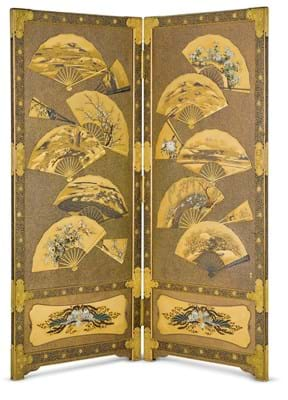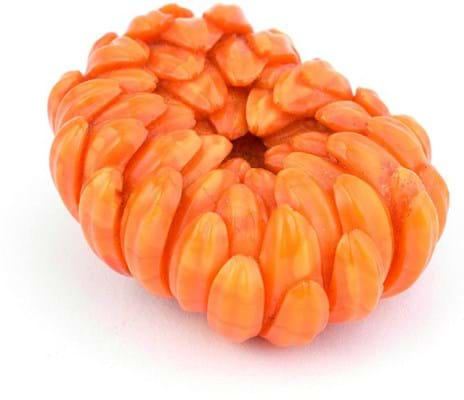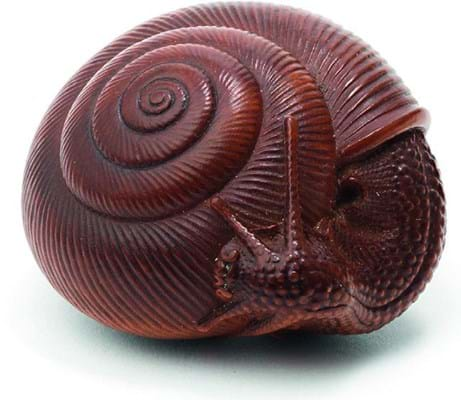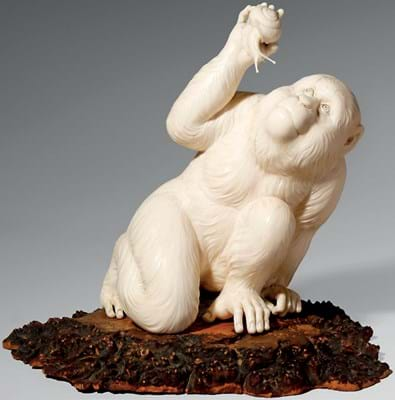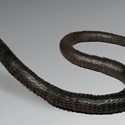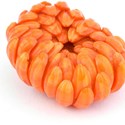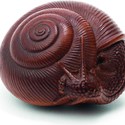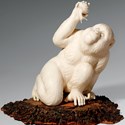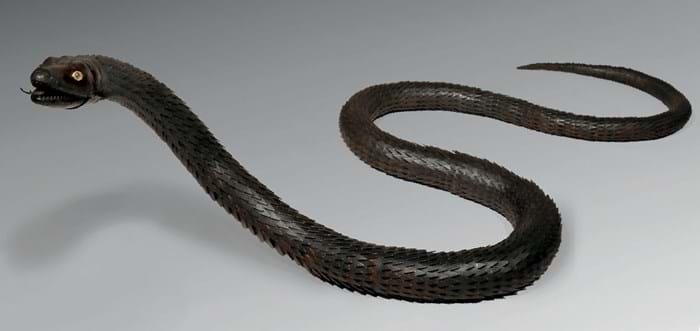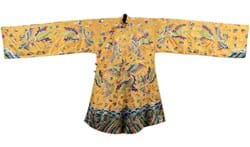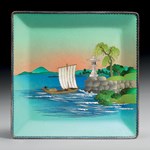It reflected both the availability of some blue-chip lots around which to make a sale and the securing of the talents of a rival (consultant Mark Hinton left Christie’s for its neighbour earlier this year), but also perhaps a sign that elements at least of the Japanese market are more robust than they were in the late 2000s.
There were two stand-out results for Western-inspired lacquer works from quite different periods.
A late 16th century nanban lacquer shrine glimpses at the splendours of the Momoyama during the so-called Christian century. Very few of these pieces remain today as Christianity was banned by the Tokugawa Shogunate in 1620, followed by a long campaign of execution and persecution against converts.
However, the 20 or so surviving devotional shrines show a mingling of European and Japanese Kano style: gold and brown hiramakie and mother-of-pearl frames housing oil paintings copying those brought to Japan by Francis Xavier and his fellow Jesuits. This example, measuring 17 x 12in (42 x 20cm) carried an estimate of £70,000-100,000 but sold at £190,000.
The sweeping reforms in Meiji period society brought far-reaching changes to the production and display of art. A new vogue for Western-style decor in the Victorian mode was championed in the Imperial Household - prompting Japanese artists and craftsmen to produce new types of domestic furnishings. Large room screens were among them.
“The sweeping Meiji reforms brought far-reaching changes to the production and display of art
The magnificent pair in Sotheby’s sale were signed for Yasui Hochu (1857-1922), the top-drawer lacquer artist who produced exhibition work for both the Seikosha and Kiryu Kosho Kaisha trading companies, established by the Meiji government to promote traditional Japanese craft industries abroad.
Across a panorama of chrysanthemum blooms, fans, mountainous landscapes, water birds and wild flowers, the 6ft 3in x 2ft 10in (1.89m x 85cm) two-fold screens display the full range of gold and silver lacquer techniques and very fine shibayama-style inlay in mother-of-pearl and stained ivory. Estimated at £500,000-700,000, the pair sold at £600,000 – a new record for a Meiji period work of art. Overall the sale grossed £2.5m with a respectable 95 of 146 lots sold.
A market of brand names
The market for the best Meiji material is still dominated by brand names.
Two 4in (12cm) square dishes from the workshop of cloisonné master Namikawa Yasuyuki – a relatively late design from c.1903 with landscape decoration – carried modest estimates of £1000- 2000 and £3000-5000 at the Japanese art sale at Woolley & Wallis on November 14. Bonhams sold a koro and cover with similar decoration last year for an unexpected £35,000.
These W&W examples came from the Weber family collection, Bristol – source of two Komai-style models of pagodas sold in Salisbury last November – and had been acquired in the early 20th century.
The first, with an apple-green ground and a striking striped polychrome border had some damage but took £13,000. The second, in good condition with a sage ground and a central scene of a sailboat, took £18,000.
Ivory can be a problem material in the Japanese market and it had been a surprise that an ivory okimono of a monkey by Ishikawa Komei (1852- 1913) sold for £19,000 at Bonhams in May 2017. This strong price brought a very similar group by the Tokyo School carver to market in Salisbury – again superbly worked with the primate here appearing to smile as it ponders a snail travelling across its palm. Signed to the base, it got away at the lower end of a £15,000-20,000 estimate.
Komei belonged to a generation of artists who – with the abolition of the sword-wearing samurai class in 1868 – sought new customers for their crafts. Some turned towards producing everyday objects for the upper classes. Others specialised in making okimono (ornaments for display) that proved attractive souvenirs for wealthy tourists in Japan at the turn of the century.
Jizai okimono – a subcategory of fully articulated iron sculptures – can be a feat of ingenuity, as demonstrated by a 4ft 1in (1.24m) model of a snake that topped this sale at £27,000 (estimate £20,000-30,000). Signed Muneyoshi (a member of the Myochin family of armour makers), its fully articulated body is constructed of a multitude of triangular hammered plates simulating scales with a hinged jaw opening to reveal a movable forked tongue. A similar model by the same workshop is in the British Museum.
The hammer total for the sale was £215,000 – an encouraging figure, said specialist Alex Aguilar: “The market for Japanese art has been rather slow in the last few decades and the success of this sale shows that it is picking up again.”
Bonhams’ Japanese sale on November 8 was topped at £75,000 by a fine boxwood netsuke snail emerging from its shell by Naito Toyomasa (1773-1856). Once in the collection of Joseph and Edith Kurstin (published in 1980), in a reserve is an inscription that translates as ‘Made by Toyomasa, living in Sasayama, Tanba Province, at the age of 62’.
Snails are a relatively unusual netsuke subject although similar signed studies by Toyomasa sold for £34,000 at Sotheby’s in 2002 and £34,850 as part of the Harriet Szechenyi sale at Bonhams in November 2011.
Toyomasa, who typically worked in stained boxwood, is sometimes described as a ‘transitional’ artist who bridges the spontaneity of the 18th century style and 19th century realism. His considerable talents had been on view two days earlier (November 6) as Bonhams sold the third and final part of the extraordinary collection of netsuke formed by US concert pianist Julius Katchen (1926-69) and his wife Arlette.
The couple made their first purchase in Kyoto while on a concert tour of Japan in 1953, later immersing themselves in the subject with the encouragement of London dealer Geoffrey Moss. Many important purchases were made in the 1960s at the time of the legendary Mark Hindson and Frederick Meinertzhagen dispersals.
The collection had already yielded an ivory netsuke of a shaggy dog and pup by the enigmatic carver Gechu (£180,000 in the first Katchen sale in November 2016) and an ivory recumbent ox by Tomotada (£120,000 in May 2017).
Toyomasa’s netsuke of a seated sabre-toothed tiger, purchased at Hamburg auction house Haus-wedell and Nolte in 1963 and sold at £23,000, was, like all the other pieces in this sale, worked in (largely) controversy-free organic materials.
There were examples in wood, stag antler, marine ivory, bone, bamboo, hornbill casque, lacquer, amber, metal alloy and umamitsu. But none in elephant ivory.
An amber netsuke of a single curling chrysanthemum bloom by the Osaka carver Kaigyokusai Masatsugu (1813-92) sold at £18,000. It has a deep provenance including the Albert Brockhaus collection (it is pictured in his 1905 book Netsuke), the Charles A Greenfield collection (published 1972) and the Joseph Kurstin collection (published 1985).
Sold at £32,000 was a boxwood rat scratching its neck with one hind foot signed by the late 18th century Kyoto carver Masanao (once part of Meinertzhagen collection and purchased in 1961). A model of a recumbent dog by the same artist (once in the Andrew Somlyo collection, purchased in 1965) took £15,000.
A toast to kakiemon
Cheffins’ (22.5% buyer’s premium) attempt to sell ancient Chinese bronzes from a Hong Kong collection in Cambridge on November 8 fell short of expectations.
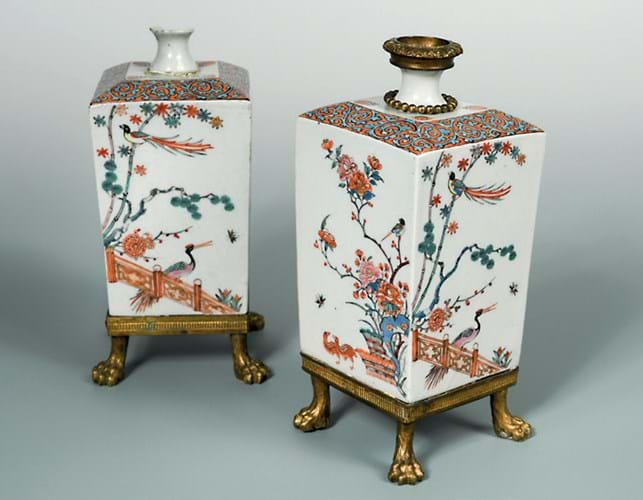
A pair of Japanese kakiemon sake bottles, or tokuri, painted on all four sides with garden birds – £7000 at Cheffins.
However, the firm enjoyed more success with mixed-owner material including a pair of Japanese kakiemon sake bottles, or tokuri, painted on all four sides with garden birds. The pair stood 8in (20cm) high on 18th century European ormolu mounts. Despite condition issues – as well as chips and cracks, one neck was broken and reglued – they trebled hopes at £7000.


